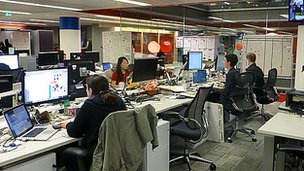They can be noisy and distracting or depressingly quiet, and frictions with co-workers are guaranteed – so why do so many of us continue to work in open-plan offices?

In the spring of 1962, a fourth-year British architectural student was tasked with sketching an office layout.
In the course of his research, Frank Duffy stumbled across a small article in a trade magazine about a new workplace design that had taken hold in Germany. Accompanying the article was a curious photograph.
“The arrangement of the desks was somehow organic,” Duffy recalls. “And there were other features that were striking. There were lots of plants around the place, and a carpet.”
The office in the photograph was open-plan, but it was a world away from the open-plan offices with which everyone was then familiar.
These had arrived about a century earlier, when architects had started to use cast-iron girders to open up larger spaces within a building. In the American industrial boom of the late 19th Century, bosses jumped at the chance to replicate their beloved factory lines with ranks of pen-pushers.
Clerical workers sat at small desks in straight rows, often facing the same way – a classroom without a teacher.
Those further up the food chain had their own office, and the boss generally had a large corner office with windows on two sides. His lieutenants – usually men – would be despatched to survey the activities of the secretarial pool – usually women.
“The office, especially the North American office, comes in a military, top-down nature,” says Frank Duffy. It is no coincidence, he says, that the 20th Century reaction against the top-down office layout started in Germany as “fundamentally a reaction against Nazism”.
The concept, devised by the consultants Quickborner, was called Burolandschaft – office landscaping. A glance at a layout chart from that time reveals desks scattered in a seemingly higgledy-piggledy fashion, with desks butting up against each other every which way, and clustered in work zones of different sizes.
In fact, the layouts were anything but random. “The layout was based upon an intensive study of patterns of communication – between different parts of the organisation, different individuals,” says Duffy, who became a leading exponent of Burolandschaft.
Whereas in the secretarial pool chatter was frowned upon, the new type of open-plan office encouraged disclosure, discussion and debate.
Managers were mixed in with the masses, cutting down on the expense of managerial offices and allowing organisations to manage their workforce more flexibly. If someone got a promotion, they wouldn’t graduate to a new or larger office – they might not need to change desks at all.
But the many millions of people working in this kind of open-plan office today know that there is such a thing as too much communication. Proximity to our colleagues makes it easier to have a spontaneous micro-meeting, but it also means we have to sit through their deconstruction of the previous night’s TV, or their shouting matches with teenage children over the phone.
“Nobody can understand two people talking at the same time,” says Julian Treasure, chairman of the Sound Agency.
“Now that’s key when we’re talking about open-plan offices, because if I’m trying to do work, it requires me to listen to a voice in my head to organise symbols, to organise a flow of words and put them down on paper.”
If someone else is speaking your “auditory bandwidth” is full, he says, and it becomes very hard to listen to that voice in your head.
A 1998 study in the British Journal of Psychology found that background noise containing irrelevant speech affected workers’ ability to memorise prose and do mental arithmetic.
But Alexi Marmot, an architect and lecturer at University College London, says that although loud background noise probably does affect workers’ ability to concentrate, and therefore their productivity, another key question for management is how agreeable the environment is for employees.
And in some open-plan offices, particularly the “classroom” type, there can be too little noise.
“In many open-plan offices, the argument is exactly the opposite – it’s deathly quiet,” she says. “A lot of open-plan offices are just rows of people only working at their computers. And people don’t want to be there.”
The quieter the office, the harder it becomes to have confidential or personal conversations. A certain amount of noise seems to be desirable – like the hum of a busy restaurant that allows a table of two to enjoy a private conversation.
Some companies are looking to technology to help get this balance right – broadcasting “pink noise” from speakers (a sound similar to white noise, which makes human speech less discernible).
Open-plan office workers also have other irritations to put up with.
There is the shortage of daylight and the ongoing squabbles with colleagues, over the air conditioning (on or off?) the blinds (up or down), food at the desk, the telephone ring tone…
A 2009 review article published in the Asia-Pacific Journal of Health Management found that 90% of studies looking at open-plan offices linked them to health problems such as stress and high blood pressure.
Although there is some evidence to show that younger employees value rubbing shoulders with more experienced colleagues, it seems that for many the cons outweigh the pros. A 2009 study in Sweden found that occupants of private offices were most happy with their environment, while most dissatisfaction was registered in medium and large open-plan offices.
In the 1970s, the “co-determination” movement swept across Europe. Legislation in Germany, the Netherlands, Sweden and Italy gave workers a say in how companies were run and offices were designed.
“That led ultimately to the rejection of office landscaping in Germany and in Scandinavia,” says Frank Duffy. Northern European office buildings today are “highly cellular”, he says, with everyone having “the right to a window they can open, a door they can shut and a wall they can beat upon”.
In his 2000 book The European Office, Juriaan van Meel noted that in Sweden “almost everybody has a private office”, while in Germany “open-office layouts are scarce” – although small teams sometimes shared a room.
German office workers have an average 28.2 sq m of personal space. Their right to elbow room and daylight is enshrined in law.
The office buildings that meet such requirements generally have separate wings of long corridors, with small offices on either side. Some, the most ambitious, have a central “street” where employees can come together to collaborate.
In the UK and North America, by contrast, design is mostly driven by cost rather than worker satisfaction, and open-plan layouts remain the norm.
In London’s West End, space for one desk (4 sq m) costs £8,500 ($13,000) a year. A private office would cost much more than that – and have a larger carbon footprint.
One compromise popular in the US is the cubicle, in which desk space is enclosed by canvas-covered dividers, usually around 5ft (1.5m) high. It’s a set-up which blocks daylight and, supposedly, office distractions.
But Duffy describes the cubicle-style layout as “a disease, a pathology of the office”, which has infected thinking about the workplace across his 40-year career.
“It doesn’t give you privacy, it doesn’t give you control over your environment,” he says.
Chairs and desks are now more adjustable, but the basic layout – cubicles aside – of many North American offices has not altered much in 100 years. Many people are still sitting together in a large room at separate desks, and still aspiring to that big corner office.
For Alexi Marmot, office layout shouldn’t be a compromise between private and public space, but one which offers both things to its employees whenever they need them. She gives the analogy of soloists in an orchestra, who need to spend hours practising alone before coming together to rehearse and perform.
Her vision doesn’t include rows of desks – in fact, it might not include any desks at all.
“We know from what young people are telling us that they prefer much more free-flowing places,” says Marmot, “the idea of hanging about anywhere with your laptop and various other mobile devices, with coffee in any posture you care to have – not necessarily on a five-star chair.”
She describes a building she visited in Switzerland which offered workers a choice of sofas, coffee table areas, libraries, pool-style recliner chairs and even “a botanical garden with a few work tables among the plants”.
But to give employees the freedom to wander about with their laptops, hiding from colleagues or seeking them out as they wish, may mean some organisations have to rethink the way they work and communicate.
“The building’s easy, the architecture’s easy,” says Duffy. “It’s thinking about how to use the buildings that really is challenging.”





